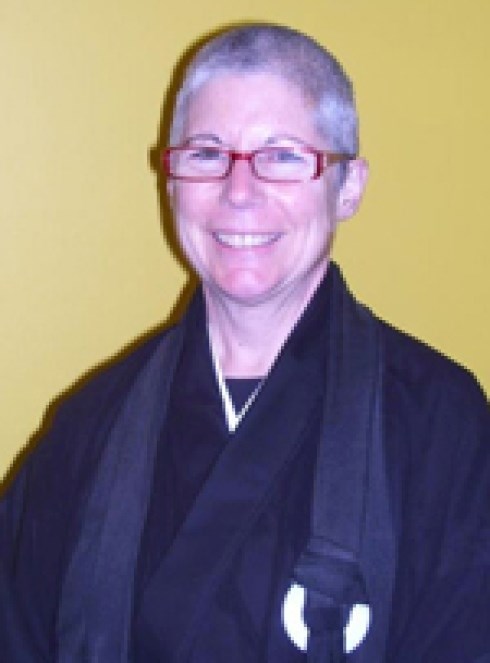 How do I make sense of my life? Is this all? What can I do about the maelstrom of feelings, ideas, habits, blind spots, and deep connection, which rules my body and mind? What will give me peace? I’m doing ok, but I’m not happy in my own skin.
How do I make sense of my life? Is this all? What can I do about the maelstrom of feelings, ideas, habits, blind spots, and deep connection, which rules my body and mind? What will give me peace? I’m doing ok, but I’m not happy in my own skin.
These are a few of the questions that led me to dedicated Zen practice, becoming a Buddhist through the Jukai ceremony, and then becoming ordained as a priest. Whereas Zen practitioners of old faced extremely difficult times, they did not experience the stress of the turning of the screw, the relentless bad news that we have had in the last decade. Zen practice helps me weather these difficult times and be pro-active in doing all I can to help mitigate the effects of environmental collapse and climate change, and to work towards social justice.
Becoming a priest is not required. The same practice is available to all who find a teacher.
I’ve come to realize two things: the practice works for me, and additionally, learning to relax helps my practice. The two go hand in hand. Yoga was designed in ancient times to help meditators in their practice. It works gently towards the all-important Shivasana or corpse pose – total relaxation.
Zen practice for a beginner is about sitting still, in silence, on the cushion for a few minutes a day. I take up the position on the cushion or in a chair and follow the breath in and out of the body, maybe counting as I go. Whenever I notice that my mind has wandered, as it very certainly will, I just gently nudge it back to the breath and restart the counting at one.
Working with koans is also a part of Zen – starting often with the Koan Mu, dissolution. These koans are stories or cases that demonstrate a particular point about the practice. Gradually over a long time my mind has learned to stay with the breath, and be present to sensory input and thoughts, just letting them wash over me as much as is possible.
Coming back from daydreams and thoughts over and over again to feel the breath in the body, or to mu, I’ve felt some peace, and some deepening of my awareness. I’m trained as a scientist, so have an investment in analytical thought, but I feel a pull towards something I can describe as feeling deeper, or more connected, or allowing my thoughts to play.
I am drawn to images of letting go, of falling, like the leaves off a tree. My teacher says we are as leaves on branches of a great tree, connected to the trunk and to the roots, bridging heaven and earth. As explorers and travellers along the way, we can move freely between leaf, trunk, roots and being the whole tree.
As I’ve practiced on the cushion, I’ve noticed meditative states of mind spilling out into my everyday life. I sometimes feel calmer, more purposeful, joyful even. I sometimes feel terrible, fearful, full of anxiety. I seem to be able to notice my individual feelings, not so much just a miserable soup, but discernable feelings with body locations to go with them. As well, there is an opinion of liking or disliking that feeling; wanting to feel more, or wanting to suppress it.
As a person who values being awake and aware of the dangers of our times, I am very motivated to learn how to decrease my chronic stress and improve my level of self-care.
Relaxation seems to be key. I was stressed, unable to feel fully, overwhelmed by the huge, stormy, Narnia-like experience of being human. One teacher of old, told students to imagine practising with a block of butter balanced on the head. I do this and find that as the imaginary butter melts, the tense muscles do too.
A healer in my life suggested I tune in to the wonderful example of my cat. He’s relaxed in every muscle until there’s a need to move one. Then that particular muscle, or set of muscles tenses – the rest stay relaxed. I found my mind does not need to get involved, as I can simply open up, be fully with my cat, and learn directly through his quiet example.
As I learn to be curious and listen to the tension, I notice fleeting feelings that would otherwise stay in the unconscious realm. These feelings have stories attached to them, which when I pay attention, can be integrated and released. Telling myself the story of that feeling helps me to accept it, helps it to heal.
Just the process of sitting in quiet meditation with these feelings as they come up, not getting into the angst (or suffering) around them, but just letting them be, in deep acceptance, heals them.
The practice of sitting meditation coupled with mindfully relaxing muscles as I do everyday tasks, has given me a more balanced outlook, in which feelings flow rather than being so very stuck, and joy and happiness are a possibility. This letting go physically, releasing tensions and fears, allows connection to something greater than myself, to the cosmic, to the unfathomable. My experience becomes rounder, fuller somehow. Paying attention, I’m touched by the infinite in small nearby things: an ant crawling on a leaf, a bird’s soft call, heartbreak, the poetry of Eve Joseph.
 Rev. Soshin McMurchy, a settler of English and Scottish ancestry born on Treaty 6 territory, lives on the ancestral lands of the SENĆOŦEN and Lekwungen speaking peoples, and as a priest with Zenwest Buddhist Society, zenwest.ca, serves as a Buddhist Chaplain with the University of Victoria Multifaith Services where she teaches meditation. She works part-time at the Greater Victoria Public Library and lives with her partner of 40 years.
Rev. Soshin McMurchy, a settler of English and Scottish ancestry born on Treaty 6 territory, lives on the ancestral lands of the SENĆOŦEN and Lekwungen speaking peoples, and as a priest with Zenwest Buddhist Society, zenwest.ca, serves as a Buddhist Chaplain with the University of Victoria Multifaith Services where she teaches meditation. She works part-time at the Greater Victoria Public Library and lives with her partner of 40 years.
You can read more articles on our interfaith blog, Spiritually Speaking, HERE
Photo of bird by Vincent van Zalinge on Unsplash


